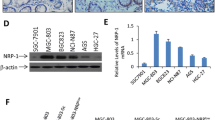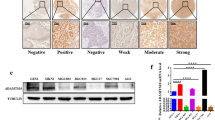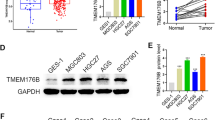Abstract
Neurotensin (NT) is distributed throughout the brain and gastrointestinal tract. Although the relationship between NT and matrix metalloproteinase-9 (MMP-9) activity in gastric cancer has not been reported, the elevation of MMP-9 and NT is reported in the breast, lung, prostate, and gastric cancer. The aim of our study is to investigate the relationship between NT and MMP-9 activity and the underlying signaling mechanism in gastric cancer cell lines. Commercial ELISA kits were used for estimation of NT and MMP-9 expression, and fluorescence resonance energy transfer (FRET) assay was used for measurement of MMP-9 activity. Cell migration and invasion were determined by wound healing and transwell assay. The expression of signaling proteins was measured by Western blotting. Our study reveals a positive correlation between increased plasma NT and MMP-9 activity in both of patient’s serum and gastric cancer cell lines. A dose-dependent elevation of MMP-9 activity was observed by NT treatment in gastric cancer cells (MKN-1 and MKN-45) compared to untreated gastric cancer and normal epithelial cell (HFE-145). Moreover, NT-mediated migration and invasion were observed in gastric cancer cells unlike in normal cell. The signaling mechanism of NT in gastric cancer cells was confirmed in protein kinase C (PKC), extracellular-signal regulated kinase (ERK), and phosphatidylinositol 3-kinase (PI3K) pathway. In addition, pretreatment of gastric cancer cells with NTR1 inhibitor SR48692 was shown to significantly inhibit the NT-mediated MMP-9 activity, cell invasion, and migration. Our finding illustrated NTR1 could be a possible therapeutic target for gastric cancer.






Similar content being viewed by others
References
Parkin DM, Ferlay J, Curado MP, Bray F, Edwards B, Shin HR, et al. Fifty years of cancer incidence: CI5 I-IX. Int J Cancer. 2010;127:2918–27.
Mirvish SS. Gastric-cancer and salivary nitrate and nitrite. Nature. 1985;315:461–2.
Wroblewski LE, Peek RM, Wilson KT. Helicobacter pylori and gastric cancer: factors that modulate disease risk. Clin Microbiol Rev. 2010;23:713–39.
Lo SS, Wu CW, Hsieh MC, Kuo HS, Lui WY, Peng FK. Relationship between age and clinical characteristics of patients with gastric cancer. J Gastroenterol Hepatol. 1996;11:511–4.
Ushijima T, Sasako M. Focus on gastric cancer. Cancer Cell. 2004;5:121–5.
Lam KWK, Lo SCL. Discovery of diagnostic serum biomarkers of gastric cancer using proteomics. Proteomics Clin Appl. 2008;2:219–28.
Cao M, Yie SM, Liu J, Ye SR, Xia D, Gao E. Plasma soluble HLA-G is a potential biomarker for diagnosis of colorectal, gastric, esophageal and lung cancer. Tissue Antigens. 2011;78:120–8.
Kikuchi R, Abe Y, Iijima K, Koike T, Ara N, Uno K, et al. Low serum levels of pepsinogen and gastrin 17 are predictive of extensive gastric atrophy with high-risk of early gastric cancer. Tohoku J Exp Med. 2011;223:35–44.
Carraway RE, Plona AM. Involvement of neurotensin in cancer growth: evidence, mechanisms and development of diagnostic tools. Peptides. 2006;27:2445–60.
Reubi JC, Waser B, Schmassmann A, Laissue JA. Receptor autoradiographic evaluation of cholecystokinin, neurotensin, somatostatin and vasoactive intestinal peptide receptors in gastro-intestinal adenocarcinoma samples: where are they really located? Int J Cancer. 1999;81:376–86.
Shimizu S, Tsukada J, Sugimoto T, Kikkawa N, Sasaki K, Chazono H, et al. Identification of a novel therapeutic target for head and neck squamous cell carcinomas: a role for the neurotensin-neurotensin receptor 1 oncogenic signaling pathway. Int J Cancer. 2008;123:1816–23.
Kalafatakis K, Triantafyllou K. Contribution of neurotensin in the immune and neuroendocrine modulation of normal and abnormal enteric function. Regul Peptides. 2011;170:7–17.
Vincent JP, Mazella J, Kitabgi P. Neurotensin and neurotensin receptors. Trends Pharmacol Sci. 1999;20:302–9.
Alifano M, Souaze F, Dupouy S, Camilleri-Broet S, Younes M, Ahmed-Zaid SM, et al. Neurotensin receptor 1 determines the outcome of non-small cell lung cancer. Clin Cancer Res. 2010;16:4401–10.
Seethalakshmi L, Mitra SP, Dobner PR, Menon M, Carraway RE. Neurotensin receptor expression in prostate cancer cell line and growth effect of NT at physiological concentrations. Prostate. 1997;31:183–92.
Souaze F, Dupouy S, Viardot-Foucault V, Bruyneel E, Attoub S, Gespach C, et al. Expression of neurotensin and NT1 receptor in human breast cancer: a potential role in tumor progression. Cancer Res. 2006;66:6243–9.
Tatsuta M, Iishi H, Baba M, Taniguchi H. Promotion by neurotensin of gastric carcinogenesis induced by N-methyl-N’-nitro-N-nitrosoguanidine in Wistar rats. Cancer Res. 1989;49:843–6.
Wood JG, Hoang HD, Bussjaeger LJ, Solomon TE. Neurotensin stimulates growth of small-intestine in rats. Am J Physiol. 1988;255:G813–7.
Hasegawa K, Kar S, Carr BI. Stimulation of hepatocyte DNA-synthesis by neurotensin. J Cell Physiol. 1994;158:215–22.
Sillem M, Prifti S, Koumouridis A, Runnebaum B. Invasiveness corresponds to differentiation rather than to proteinase secretion in endometrial cancer cell lines. Eur J Gynaecol Oncol. 1999;20:367–70.
Kim YM, Ku MJ, Son YJ, Yun JM, Kim SH, Lee SY. Anti-metastatic effect of cantharidin in a549 human lung cancer cells. Arch Pharm Res. 2013;36:479–84.
Groblewska M, Siewko M, Mroczko B, Szmitkowski M. The role of matrix metalloproteinases (MMPs) and their inhibitors (TIMPs) in the development of esophageal cancer. Folia Histochem Cytobiol. 2012;50:12–9.
Li L, Tan J, Zhang Y, Han N, Di X, Xiao T, et al. DLK1 promotes lung cancer cell invasion through upregulation of MMP9 expression depending on Notch signaling. PLoS One. 2014;9:e91509.
Zheng SQ, Chang YH, Hodges KB, Sun Y, Ma XB, Xueyi NON, et al. Expression of KISS1 and MMP-9 in non-small cell lung cancer and their relations to metastasis and survival. Anticancer Res. 2010;30:713–8.
Maatta M, Soini Y, Liakka A, Autio-Harmainen H. Differential expression of matrix metalloproteinase (MMP)-2, MMP-9, and membrane type 1-MMP in hepatocellular and pancreatic adenocarcinoma: implications for tumor progression and clinical prognosis. Clin Cancer Res. 2000;6:2726–34.
Aalinkeel R, Nair BB, Reynolds JL, Sykes DE, Mahajan SD, Chadha KC, et al. Overexpression of MMP-9 contributes to invasiveness of prostate cancer cell line LNCaP. Immunol Investig. 2011;40:447–64.
Leifler KS, Svensson S, Abrahamsson A, Bendrik C, Robertson J, Gauldie J, et al. Inflammation induced by MMP-9 enhances tumor regression of experimental breast cancer. J Immunol. 2013;190:4420–30.
Kang MH, Kim JS, Seo JE, Oh SC, Yoo YA. BMP2 accelerates the motility and invasiveness of gastric cancer cells via activation of the phosphatidylinositol 3-kinase (PI3K)/Akt pathway. Exp Cell Res. 2010;316:24–37.
Liao A, Wang W, Sun D, Jiang Y, Tian S, Li J, Yang X, Shi R. Bone morphogenetic protein 2 mediates epithelial-mesenchymal transition via AKT and ERK signaling pathways in gastric cancer. Tumour Biology: the Journal of the International Society for Oncodevelopmental Biology and Medicine. 2014.
Thant AA, Nawa A, Kikkawa F, Ichigotani Y, Zhang YY, Sein TT, et al. Fibronectin activates matrix metalloproteinase-9 secretion via the MEK1-MAPK and the PI3K-Akt pathways in ovarian cancer cells. Clin Exp Metastasis. 2001;18:423–8.
Itoh S, Hamada E, Kamoshida G, Takeshita K, Oku T, Tsuji T. Staphylococcal superantigen-like protein 5 inhibits matrix metalloproteinase 9 from human neutrophils. Infect Immun. 2010;78:3298–305.
Yao GY, Zhou JL, Lai MD, Chen XQ, Chen PH. Neuroendocrine markers in adenocarcinomas: an investigation of 356 cases. World J Gastroenterol. 2003;9:858–61.
FernandezFernandez L, Tejero E, Tieso A, Rabadan L, Munoz M, Santos I. Receiver operating characteristic (ROC) curve analysis of the tumour markers CEA, CA 19-9 and CA 72-4 in gastric cancer. Int Surg. 1996;81:400–2.
Sier CF, Kubben FJ, Ganesh S, Heerding MM, Griffioen G, Hanemaaijer R, et al. Tissue levels of matrix metalloproteinases MMP-2 and MMP-9 are related to the overall survival of patients with gastric carcinoma. Br J Cancer. 1996;74:413–7.
Zheng H, Takahashi H, Murai Y, Cui Z, Nomoto K, Niwa H, et al. Expressions of MMP-2, MMP-9 and VEGF are closely linked to growth, invasion, metastasis and angiogenesis of gastric carcinoma. Anticancer Res. 2006;26:3579–83.
Chinni SR, Sivalogan S, Dong Z, Trindade JC, Deng XY, Bonfil RD, et al. CXCL12/CXCR4 signaling activates Akt-1 and MMP-9 expression in prostate cancer cells: the role of bone microenvironment-associated CXCL12. Prostate. 2006;66:32–48.
Lee CW, Lin CC, Lin WN, Liang KC, Luo SF, Wu CB, et al. TNF-alpha induces MMP-9 expression via activation of SRC/EGFR, PDGFR/PI3K/Akt cascade and promotion of NF-kappab/p300 binding in human tracheal smooth muscle cells. Am J Physiol Lung Cell Mol Physiol. 2007;292:L799–812.
Chung TW, Lee YC, Kim CH. Hepatitis B viral HBx induces matrix metalloproteinase-9 gene expression through activation of ERK and PI-3K/AKT pathways: involvement of invasive potential. FASEB J : Off Publ Fed Am Soc Exp Biol. 2004;18:1123–5.
Cheng JC, Chou CH, Kuo ML, Hsieh CY. Radiation-enhanced hepatocellular carcinoma cell invasion with MMP-9 expression through PI3K/Akt/NF-kappaB signal transduction pathway. Oncogene. 2006;25:7009–18.
Guha S, Lunn JA, Santiskulvong C, Rozengurt E. Neurotensin stimulates protein kinase C-dependent mitogenic signaling in human pancreatic carcinoma cell line PANC-1. Cancer Res. 2003;63:2379–87.
di Florio A, Sancho V, Moreno P, Delle Fave G, Jensen RT. Gastrointestinal hormones stimulate growth of foregut neuroendocrine tumors by transactivating the EGF receptor. BBA Mol Cell Res. 2013;1833:573–82.
Zachary I, Rozengurt E. Modulation of the epidermal growth-factor receptor by mitogenic ligands: effects of bombesin and role of protein-kinase C. Cancer Surv. 1985;4:729–65.
Acknowledgments
This study was supported by the Creative Fusion Research Program through the Creative Allied Project funded by Korea Research Council of Science and Technology (CAP-12-1-KIST) and Korea Institute of Science and Technology (KIST) Institutional Program (project no. 2E25360).
Conflicts of interest
None
Author information
Authors and Affiliations
Corresponding author
Electronic supplementary material
Below is the link to the electronic supplementary material.
Supplementary Fig. 1
(PPTX 399 kb)
Rights and permissions
About this article
Cite this article
Akter, H., Park, M., Kwon, OS. et al. Activation of matrix metalloproteinase-9 (MMP-9) by neurotensin promotes cell invasion and migration through ERK pathway in gastric cancer. Tumor Biol. 36, 6053–6062 (2015). https://doi.org/10.1007/s13277-015-3282-9
Received:
Accepted:
Published:
Issue Date:
DOI: https://doi.org/10.1007/s13277-015-3282-9




